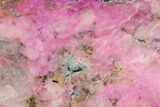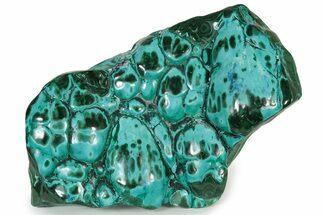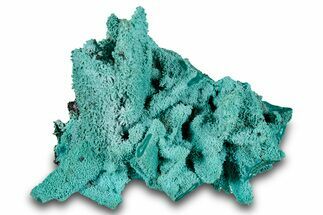This Specimen has been sold.
5.9" Polished Cobaltoan Calcite & Chrysocolla Slab - Congo
This is a hand-polished slab of pink cobaltoan calcite from the Congo. The lapidary work is nice, and allows for the vivid coloration of the cobaltocalcite to be easily seen. There is also a metallic luster that shines in the light when the specimen is rotated, that can be attributed to the formation of native copper. However, most of this luster has been covered by the blue-green chrysocolla formations (copper oxidation) within the slab. It comes with an acrylic display stand.
Cobaltoan calcite, also known as cobaltocalcite is one of many different varieties of calcite, forming with a chemical composition of (Ca,Co)CO3. It crystallizes in a trigonal crystal system, and it forms rhombohedral or scalenohedral crystals. These crystals tend to display a pink color of which intensity can range anywhere from a pinkish-salmon to a hot pink.
Cobaltoan calcite, also known as cobaltocalcite is one of many different varieties of calcite, forming with a chemical composition of (Ca,Co)CO3. It crystallizes in a trigonal crystal system, and it forms rhombohedral or scalenohedral crystals. These crystals tend to display a pink color of which intensity can range anywhere from a pinkish-salmon to a hot pink.
Chrysocolla is a basic copper silicate that typically forms as a pseudomorph following other copper based minerals. The chemical formula is considered undetermined due to the varying substitutions of elements and water content in its chemical structure. However, there is a form of chrysocolla with an identifiable chemical formula of Cu2H2Si2O5(OH)4 that can be found in microcrystals.
Regularly, chrysocolla will form as botryoidal lumps and spheres, rarely forming visible crystals. It can also form in both solid and fibrous veins, over fibrous minerals, and in crusts. Known for its sharp and vibrant coloring, chrysocolla can display a wide variety of colors such as bluish-green, bright green, light blue, to even sometimes multicolored specimens depending on the atmosphere present during formation.
Regularly, chrysocolla will form as botryoidal lumps and spheres, rarely forming visible crystals. It can also form in both solid and fibrous veins, over fibrous minerals, and in crusts. Known for its sharp and vibrant coloring, chrysocolla can display a wide variety of colors such as bluish-green, bright green, light blue, to even sometimes multicolored specimens depending on the atmosphere present during formation.
SPECIES
Calcite var. Cobaltoan & Chrysocolla
LOCATION
Katanga Province, Congo
SIZE
5.9" wide, 5" tall, .6" thick
CATEGORY
SUB CATEGORY
ITEM
#95010
 Reviews
Reviews













